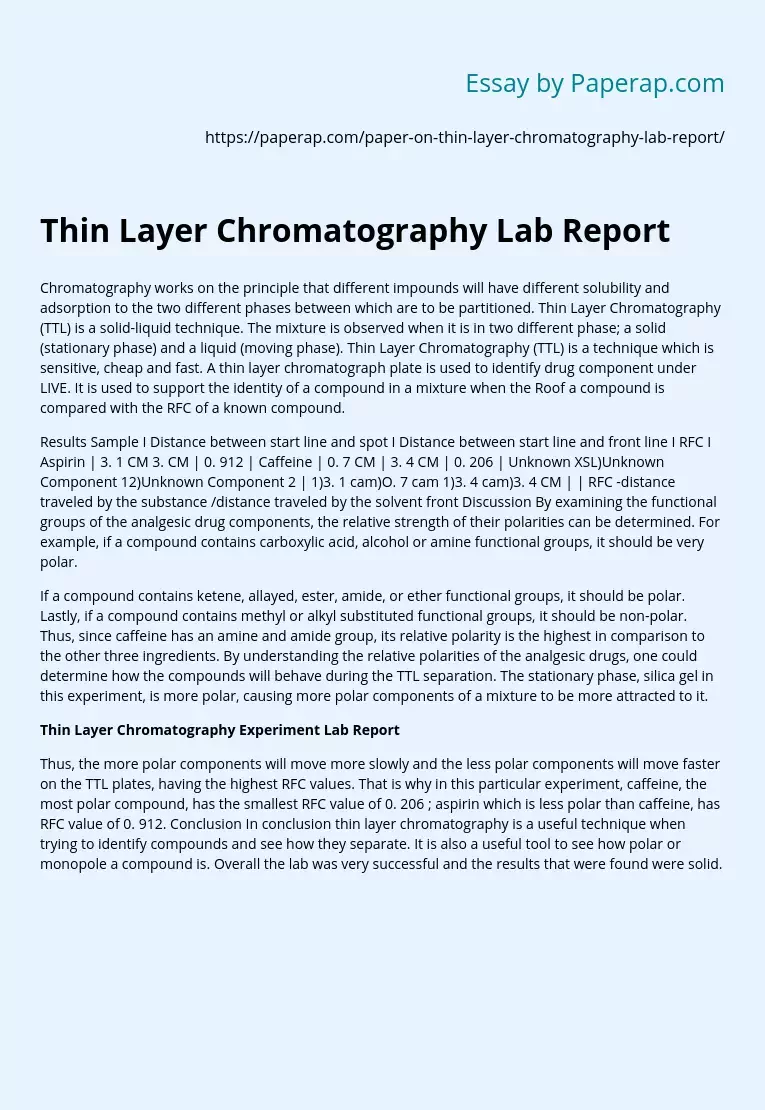Thin Layer Chromatography Lab Report
Chromatography works on the principle that different impounds will have different solubility and adsorption to the two different phases between which are to be partitioned. Thin Layer Chromatography (TTL) is a solid-liquid technique. The mixture is observed when it is in two different phase; a solid (stationary phase) and a liquid (moving phase). Thin Layer Chromatography (TTL) is a technique which is sensitive, cheap and fast. A thin layer chromatograph plate is used to identify drug component under LIVE. It is used to support the identity of a compound in a mixture when the Roof a compound is compared with the RFC of a known compound.
Results Sample I Distance between start line and spot I Distance between start line and front line I RFC I Aspirin | 3. 1 CM 3. CM | 0. 912 | Caffeine | 0. 7 CM | 3. 4 CM | 0. 206 | Unknown XSL)Unknown Component 12)Unknown Component 2 | 1)3. 1 cam)O. 7 cam 1)3. 4 cam)3. 4 CM | | RFC -distance traveled by the substance /distance traveled by the solvent front Discussion By examining the functional groups of the analgesic drug components, the relative strength of their polarities can be determined.
For example, if a compound contains carboxylic acid, alcohol or amine functional groups, it should be very polar.
If a compound contains ketene, allayed, ester, amide, or ether functional groups, it should be polar. Lastly, if a compound contains methyl or alkyl substituted functional groups, it should be non-polar. Thus, since caffeine has an amine and amide group, its relative polarity is the highest in comparison to the other three ingredients. By understanding the relative polarities of the analgesic drugs, one could determine how the compounds will behave during the TTL separation.
The stationary phase, silica gel in this experiment, is more polar, causing more polar components of a mixture to be more attracted to it.
Thin Layer Chromatography Experiment Lab Report
Thus, the more polar components will move more slowly and the less polar components will move faster on the TTL plates, having the highest RFC values. That is why in this particular experiment, caffeine, the most polar compound, has the smallest RFC value of 0. 206 ; aspirin which is less polar than caffeine, has RFC value of 0. 912. Conclusion In conclusion thin layer chromatography is a useful technique when trying to identify compounds and see how they separate. It is also a useful tool to see how polar or monopole a compound is. Overall the lab was very successful and the results that were found were solid.
Thin Layer Chromatography Lab Report. (2019, Dec 05). Retrieved from https://paperap.com/paper-on-thin-layer-chromatography-lab-report/

